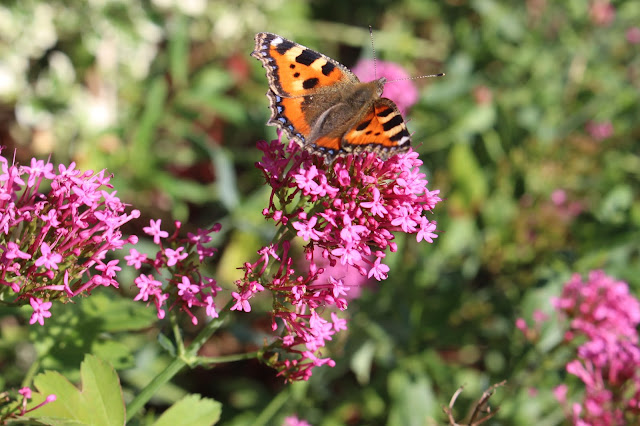Plants for butterflies
 |
| Small tortoiseshell butterfly on valerian (Centranthus ruber) |
I'm grateful to the company that offered me an expensive designer butterfly feeder recently because it led me to review how many butterfly friendly plants I could grow in my garden for the same money. The answer is loads and I'm happy to say not only do I have most of them already, they also feed a wider range of these delightful visitors.
It was also a timely reminder to grab a cup of coffee and spend a relaxing 15 minutes in the garden counting butterflies for this year's Big Butterfly Count, which runs until this Sunday (6th August 2017).
For this year's count, I paid particular attention to which plants were in the butterflies' favour. They were:
- Perennial cornflower, Centaurea montana
- Globe thistle, Echinops ritro
- Perennial wallflower, Erysimum 'Bowles Mauve'
- Phlox paniculata (they seem to prefer the white over the pink flowers)
- Ice plant, Sedum spectabile (NB now renamed as Hylotelephium spectabile)
- Verbena bonariensis
We'll draw a veil over the various white butterflies which have a liking for the nasturtiums up at my allotment. As NAH doesn't like brassicas, these are the only option for them on my plot.
Butterfly Conservation has a useful page about gardening for butterflies which shows their top plants for summer nectar - buddleia, Verbena bonarienis, Erysimum 'Bowles Mauve', lavender and marjoram. This page links to a much longer, downloadable list so you can ensure your garden is attractive to butterflies from March right through to November. There's also a downloadable list of the key food plants for caterpillars.
Which plants do your butterfly visitors prefer?










We have loads of butterfly plants including a whole row of buddleias on the plot but so very few butterflies. They used to be peacocks and tortoiseshells all over the flowers but I haven't seen any of either for a couple of years. So far this year a grand total of one comma and one red admiral have been spotted. We have plenty of large and small whites and gatekeepers but that's about it!
ReplyDeleteSpeckled woods here Sue, plus the white family and one glorious painted lady. I find tortoiseshells tend to descend on my garden the day after the butterfly watch has completed. That's a good point, butterflies tend to be quite seasonal in my garden, so I wonder how different a May or September census would be?
DeleteI've seen lots of butterflies on the plot in recent weeks, especially Gatekeepers, Small Skippers and Speckled Woods. They've been flitting around all the flowers particularly the lavender, red valerian and sunflowers. xx
ReplyDeleteOh I forgot when replying to Sue - lots of blue butterflies for me this year :)
DeleteThe busiest place in my garden right now is my Butterfly Bush, Buddleia
ReplyDeleteI am including butterfly photos in my post tomorrow
Hope you are having a great day!
Thanks Lea, you too!
DeleteI got an email too about a nectar feeder - and wrote back to ask where butterflies would lay their eggs if we were to simply to supply them with nectar . . and what would their caterpillars eat if there were no plants? But they haven't replied. I find myself in the odd position of sticking up for the (beautiful) Cabbage White.
ReplyDeleteI think that's the feeder I obliquely referred to in my post Lucy. I gave them quite a lot of feedback on why I thought it was a no goer for most people. I see it was also a Crowdfunded project at one point which didn't meet its target - that makes me think the general public broadly agree with the feedback I gave them.
DeleteA brightly coloured plastic pear with holes in? I've had a reply - that the nectar feeder is to give butterflies an extra boost of nectar and that butterflies have taste sensors on their legs which will help them find suitable plants to lay eggs on. Perhaps we should send some seeds?
DeleteThat's the one. Here's an extract from my email to them:
Delete"Thanks for your interesting email. I've had a look at the feeder and whilst the idea is great, I don't think it has the right fit with me or my blog. This is for several reasons:
It's expensive - I could buy a range of nectar rich plants for my garden to do the same job with that kind of outlay
Its funky design doesn't really fit with the look and feel of my garden
There are much cheaper, more sustainable designs on the market
According to your literature many of the butterflies which visit my garden don't feed on this kind of feeder (so we're back to growing the nectar rich plants from my first point again)
As a result, I know if I accepted your kind offer, I'd end up not using the feeder after a while. That would be a waste of resources, especially as the main shell of the feeder is made from plastic."
I got a simple thank you in reply!
They do like the oregano in my garden, but that may be because there isn't much else at the moment! I am working on adding more butterfly and bee friendly plants, including the caterpillar food plants that often get missed. I used to have jack-by-the-hedge in my old garden for the Orange Tips, I need to tuck a bit of that in a corner here.
ReplyDeleteJack-by-the-hedge appeared in my garden last year Hazel, and I spotted orange tips for the first time earlier this year :)
DeleteIt's not in flower yet VP but a popular late summer favourite butterfly snack in my garden is aster 'Little Carlow'.
ReplyDeleteI must see whether they like the asters later this year Anna - if I remember correctly they've preferred the Verbena close by instead.
Delete